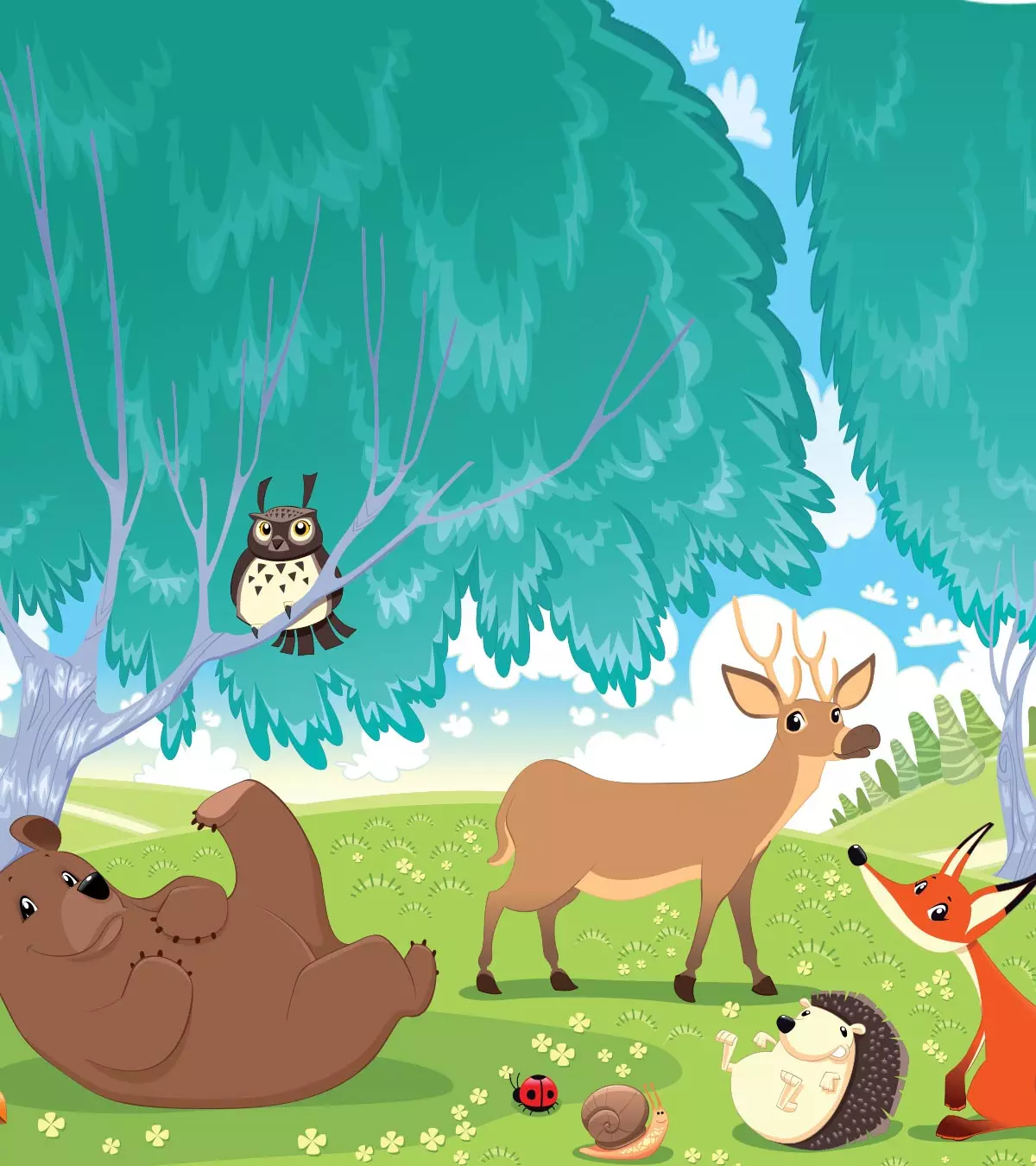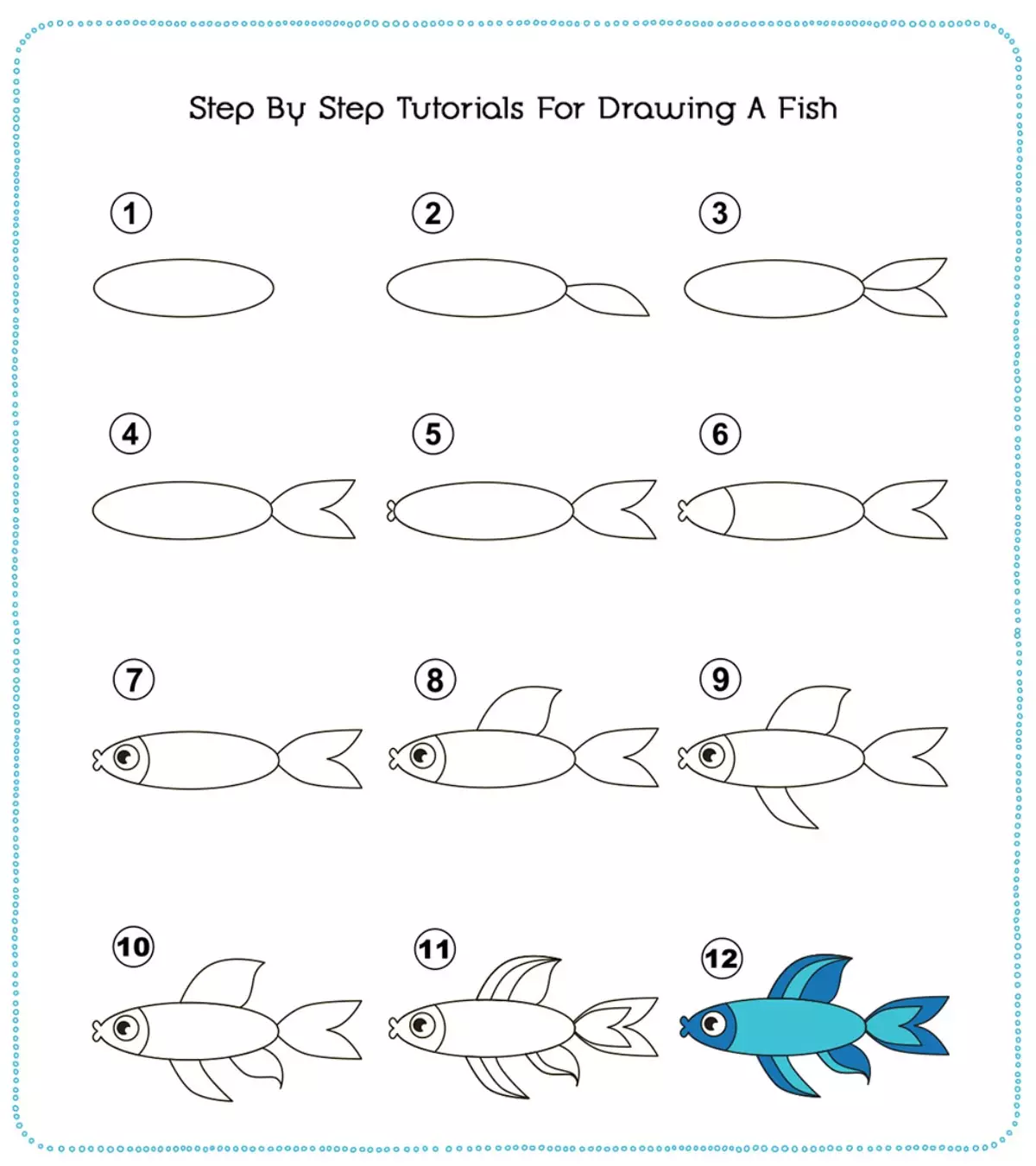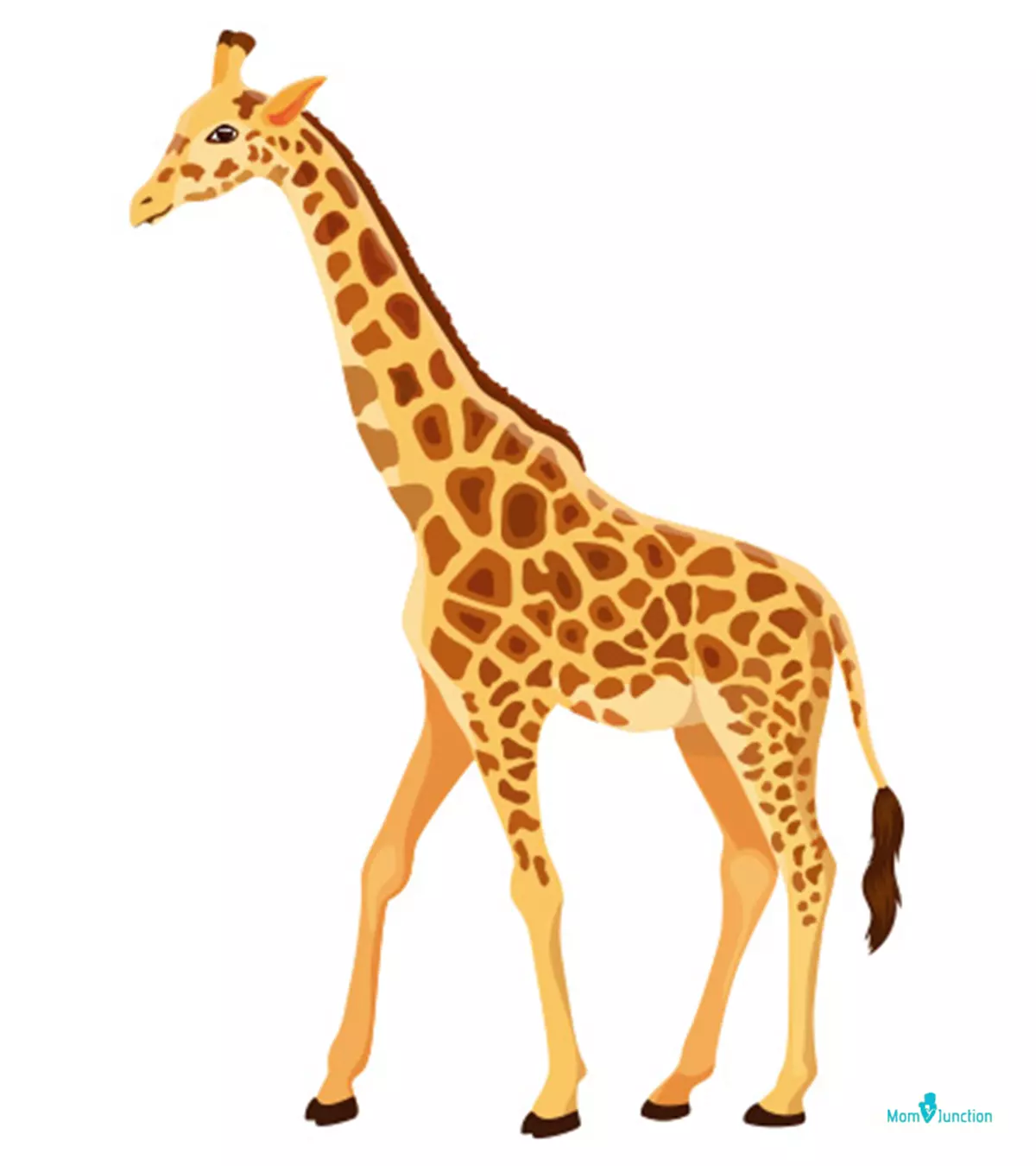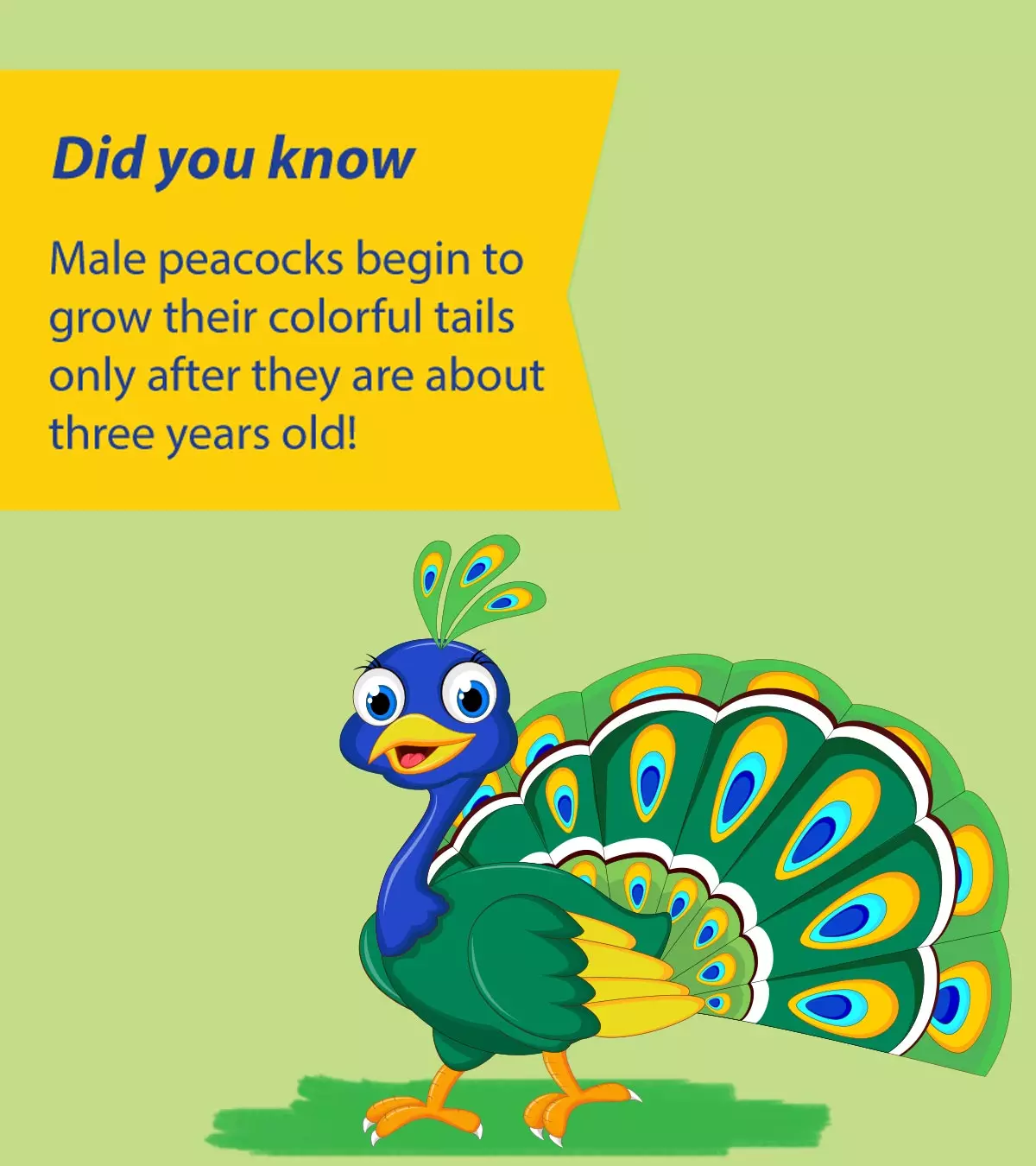
Image: MomJunction Design Team
Peacocks are fascinating creatures, and their beauty and grace leave children awestruck. So, if your child is interested in peacocks, we have brought some fun peacock facts for kids. Children seem to get excited at the sight of a peacock, and more so when they see peacocks fanning their feathers and displaying various colors and patterns. There are so many astonishing facts about peacocks that even adults might be unaware of. For example, did you know that a family of peacocks is called a bevy? So, our list of interesting facts about peacocks will be a great source of entertainment for your children and inspire them to learn more about wildlife and the natural world.

Key Pointers
- India’s national bird and Burma’s national symbol is the peacock.
- Peacocks have a wide-ranging diet that includes seeds, insects, and small animals since they are omnivores.
- The reflection of light on their feathers causes frequent color changes, resulting in their beautiful feathers, even though peacocks are brown.
- Peacocks are known to be one of the loudest creatures and make screeching sounds.
- Peachicks, even when they are only a day old, can walk, drink, and eat on their own.
25 Fun And Interesting Peacock Facts And Information For Kids
Peacocks, or peafowl belong to the pheasant family. They are native to Sri Lanka and India (1). Children and adults alike are enamored by the colorful plumage of a peacock during monsoons. Artist Xueling Zou recollects the time when her father took her to the Beijing Zoo. She writes, “There were about 20 peacocks that lived on a bird island with a hundred other birds, like crays, swans, ducks, etc…We both mentioned the same white peacock was our favorite. It seemed that white peacock heard us and turned around facing me, then opened up its feathers immediately. A lot of people clapped their hands for what they saw – the most glorious shining feathers opening up against the morning sunlight – like a Chinese fan (i).” The stunning peacock elicits this reaction from most of the people. Here are some interesting facts about this beautiful bird.
1. What Is A Peacock?
- The peacock, also widely popular as peafowl, is a medium-sized, colorful bird belonging to the pheasant familyiLarge birds from the family Phasianidae that have rounded bodies and long tails . The bird is native to Asia.
- The peacock is the national bird of India.
- About 3000 years ago, PhoeniciansiOccupants of the eastern coast of the Mediterranean Sea in the ancient civilization exported different species of peacocks to Egypt and used them for a variety of purposes, particularly home decor.
- You can find three prominent species of a peacock, namely the Indian peacock, the African Congo peacock, and the Green peacock. All three species are native to Asia, but you can also find them in Africa and certain parts of Australia today.
- Peacock is the male bird, while Peahen is the female and together they are known as peafowl. The offspring are called peachicks.
- There are three prominent species of peacock, each with unique adaptations that help them thrive in their respective habitats. The Indian peacock is known for its vibrant plumage, the African Congo peacock for its striking blue color, and the Green peacock for its iridescent feathers. Although all three species are native to Asia, they can also be found in parts of Africa and Australia.
 Did you know?
Did you know?2. Habitat And Distribution Of Peacocks:
- Peacock birds are ground-dwelling and they prefer to reside in farmlands, forests, and warm regions. They like to live in areas that provide them easy access to plants and low trees as it makes their feeding easy. They could be found in rainforests and bushlands.
- Prominently, you can find peacocks in India, Sri Lanka, and Burma.
- Peacocks are found in captivity in England and Japan. This is so that their population can be increased there.
 Quick fact
Quick fact3. What Do Peacocks Eat?
- Peacocks are omnivorous birds, and they mainly eat plants, fruits, seeds, flower petals, ants, ticks, insects, locusts, ants, bread, and other scraps in the gardens and forests. Grains are the most common food of peacocks. However, peafowls feed almost on any edible item, no matter whether it’s an animal or plant source (1).
4. Anatomy Of Peacocks:
Peacocks possess unique anatomy which makes them beautiful birds. Here, we list some prominent physical parts of the bird.
Weight And Length: Male peacock weighs around four to six kilograms, while females weigh about 2.75 to four kilograms. The length of peacocks is about six to seven feet, while the Peahens are about three to 3.5 feet long.
Head: Crested feathers similar to brush, decorate the head of the peacock creating its beautiful crown-like appearance. Peacock’s head, neck, and breast feature enticing blue appearance.
Eyes: There are white blotches above and below the eyes of a peacock.
Bill: Usually, the beak of a peacock is an inch in length.
Body: A peacock’s body has magnificent brown feathers on the front and back. Male peacock exhibits impressive greenish feathers that comprise beautiful, elongated tail trains. Peahens are less impressive than peacocks, featuring whitish faces, brown crowns, and metallic upper breasts. Peahens lack a magnificent sweeping train, unlike the males. However, males and females possess adorable green plumage, which has tan mottlings from crests to tails.
Tail: The tail of a peacock makes 60% of the entire length of the bird. Colorful, beautiful tails are characteristic of male peacocks. The color of the peacock’s tail varies every time you look at them from a different angle. The feathers on the tail possess eye-like beautiful spots with red, golden, and green feathers surrounding the eyespots. A peacock can flaunt up to 200 feathers on its tail at a time, and the bird sheds its feathers every summer.
 Quick fact
Quick fact5. What Is The Actual Color Of Peacock And Its Feathers?
Even though a peacock appears bright in color, it’s not as bright as it looks. In fact, peacocks are brown in color, and their color often changes due to the reflection of light, which is the secret of their exquisitely colorful feathers and iridescent feathers (3).
Every section of a peacock’s feather changes its color when the light strikes from different angles.
6. Can Peacocks Fly?
Yes, they can fly to limited distances as they are fleshy birds. They can cover short stretches by flying just like large birds fly. However, they prefer to stay on the ground for most of the time.
Primarily, peacocks fly to escape from predators or for their night roost. The flying style of the bird is peculiar. It feels as if the peacock is jumping, and its wings are offering it a boost to fly (4).
7. What Makes The Feathers Of Peacock So Unique And Beautiful?
The feathers of peacocks possess microscopic ‘crystal-like structures’, which tend to reflect various wavelengths of lights based on their spacing. The tiny crystal-resembling structures are the ones that create the fluorescent colors.
 Did you know?
Did you know?8. Snake Chasers
Peacocks are the best fighters when it comes to fighting with snakes. They can not only prey on young snakes, including the poisonous ones, but they also do not let snakes enter their territory.
 Trivia
Trivia9. Behavior Of Peacocks
- Peacocks are social birds, and they like to interact with humans by exhibiting magnanimity or attachment towards them. However, these birds are quite aggressive and do not approve the entry of strangers or even new peafowl in their territory.
- Peachicks cross areas only along with their parents as other peacocks could threaten their lives.
- You can also find wild peacocks playing games. Peachicks tend to chase one another around a bush by bending their heads down and holding their necks parallel to the earth. An outstanding fact is that while playing, peacocks always follow one direction, i.e., clockwise. Once tired, they stop suddenly and walk or strut at a normal pace. They love to play under the sunlight.
- Usually, these birds travel in groups of eight to ten.
- Peacocks feature a strange behavior; they create their nests on the ground and perch on the treetops.
10. How Does A Peacock Sound?
- Peacock’s call is not a pleasant experience. Peacocks are one of the loudest creatures and make screeching sounds.
- Usually, the frequency of their calls increases during the monsoon. During the rainy season, these birds make a meowing sound indicating that it’s going to rain.
- A peafowl can make 11 different calls. They love to call out in the early mornings and late evenings as a means of interacting with one another.
- Some studies reveal that peacocks sing during the mating season to impress and attract the peahens.
- In the wild, peacock calls could be an alarm of danger.
11. How Do Peacocks Reproduce?
Male peacocks display their flashy trains and beautiful blue-green plumage to attract the peahens. They perform a peculiar dance to fascinate the females. You can find them prancing around the peahens to attract them. Once mating is done, the female bird gathers various materials to create a nest. Males look for other peahens to mate. Most peacocks nest on the ground while some of them roost in trees.
Peahens lay around three to six eggs usually between January and March. The females incubate the laid eggs, which hatch in about 28 days. Peahens stay close to their offspring and are excellent mothers. The mother bird feeds the peachicks from her bill, and the peachicks respond instinctively.
12. Are Peacocks Polygamous In Nature?
Yes, peacocks are polygamous, which means that a peacock mates with more than one female. A harem of the peahens comprises two to three of them.
31. How Are Peachicks?
Peachicks weigh about 103 grams at the time of birth, and it’s hard to determine their gender. Peachicks grow up quickly and can walk around independently. After a few months, the chicks learn to fly. The male’s train of beautiful feathers develops only after three years.
14. Do Peacocks Run?
Yes, peacocks are fast runners. They can move at an excellent speed of about 16 kilometers per hour. Also, they fly pretty fast at a speed of 10 mph.
15. What Is The Cultural Importance Of Peacocks?
- Not only are peacocks the national bird of India, but they also stand for compassion, benevolence, knowledge, and kindness in Hinduism. They also stand for royalty and power in Indian culture (5).
- Hindus consider peafowl sacred, and the spots on its tail tend to symbolize the eyes of Gods.
- Lots of people co-relate peacocks with Goddess Saraswati.
- Lord Karthikeya, the Hindu God of War, also rides on a peacock.
- In Greek and Roman mythologies and folklore, Goddess Hera is associated with peacocks (6).
- For the Babylonians, peacocks are a symbol of guardians.
- The bird represents everlasting life in Christianity.
- In Islam’s Sufi cosmology, the peacock and the Tree of Certainty or shajarat al-yaqīn play a role in the fall and expulsion of Adam and Eve from Paradise (7).
16. You Don’t Have To Kill Peacocks For Its Feathers?
Yes, you do not have to kill the beautiful bird for its exquisite feathers since peacocks shed their adorable train every year soon after the breeding season ends. You can quickly gather the feathers without causing any harm to the bird.
17. Are Peacocks Domesticated Birds?
Yes, peacocks are domesticated throughout the world. Moderate weather conditions are the most favorable conditions for domestication of peacocks. You can keep these birds in open areas since they love to move in vast territories. Domesticating peacocks in a condensed area can intimidate them.
18. How To Prevent Peacocks From Being Noisy?
Peacocks turn most noisy when they feel threatened or during the mating season. Peacock calls are tolerable in the mornings but could be disturbing at night. To prevent them from being noisy, you can keep them in a dark shed or building. This stops them from calling at dawn. You could also set their perch at a height that prevents them from raising their necks to call (8).
19. Can Peacocks Make Fake Calls?
Yes, peacocks are clever birds, and they can easily make false calls. Usually, a peacock makes a loud copulatory calliLoud, rhythmic sounds used to attract potential partners for mating when he mates with a peahen. However, peacocks can fake this sound to attract a greater number of peahens by pretending to be mating. In fact, one-third of the bird’s calls that you hear tend to be fake (9).
20. What Is The Secret Of All-White Peafowls?
Selective breeding, which is common in domesticated peafowls, brings the polychromatic trend for plain white feathers. It is one of the most popular colored mutations, i.e., the variation without any color which makes the female peacock have white feathers. The entire peafowl is pure white due to its inability to create any color pigment which is well-known as leucism. You may also misunderstand white peafowl as an albino. However, the bird retains standard eye color along with leucism.
21. Who Are Peacocks’ Predators?
Peacocks suffer from the threat of a few predators such as dogs, tigers, cats, raccoons, and some medium-sized mammals.
22. Can Peacocks Swim?
No, peacocks cannot swim. They don’t have webbed feet, which are quintessential for birds to swim actively and their feathers provide no help in swimming.
23. Indian Peacocks Are The Only Species That Display Plumage:
Of all the species of peacocks, the Indian peacock is the only species that carry and show splendid plumageiA bird's completely feathered body . The other two species are quite short and possess only a few sets of feathers.
24. What Is The Conservation Status Of Peacocks?
Even though the number of peacocks is reducing, particularly due to hunting and loss of habitat, the Indian peacock is not an endangered bird. Congo peafowl is now present in the vulnerable list of species, and the Green Peafowl is an endangered species.
25. What Is The Lifespan Of Peacocks?
An average lifespan of peacocks is 15 to 20 years in the wild. However, peacocks can live up to 40 years in captivity.
10 Unknown Peacock Fun Facts For Kids
With their colorful feathers and iridescent bodies, peacocks are one of the most intriguing birds in the world. You have learned quite a lot about them now. Here are some more unique facts about peacocks.
- According to the Feng Shui, peacocks’ feathers safeguard you from threats and disasters due to the peculiar eyes of the feathers.
- Alexander the Great imported peacocks in his Mediterranean territories and penalized individuals who caught them.
- Peacocks need companionship substantially, as alone they feel heartbroken.
- Peahens choose peacocks considering the size, color, and quality of their trains.
- People believe that the white peacock brings eternal happiness.
- The gray peacock is the national symbol of Burma.
- The wingspan of a peacock is up to six feet.
- A day old chick is capable of walking, drinking, and eating by itself.
- A peacock has four toes, of which three point forward and one points directly backward. This unique toe arrangement makes it easy for the peacock to grab the branches and roost in the trees.
- Peacocks play a vital role in the ecosystem by helping control insect populations. Their diet, which includes insects, helps keep the pest population in check, making them important for their habitats.
Frequently Asked Questions
1. Do peacocks have teeth?
Peacock, like any other bird, does not have teeth. But they have a sharp pointy beak that is conical in shape. Peacocks use their beaks to hunt their prey and eat it. As their beaks are very sharp, peacocks can crack nuts easily, scratch or attack, especially during the mating season.
2. How many hours does a peacock sleep?
Peacocks can sleep from dusk to dawn and avoid staying on the ground after sunset. They usually fly up to trees and rest there. Because predators may attack them at night on the ground in the wild, the peacocks fly to certain heights to find shelter and a spot to snooze (10).
3. What do peacock feathers represent?
Peacock feathers represent protection, divinity, beauty, and dignity. Moreover, Lord Krishna in Indian mythology is always depicted with a peacock feather in His hand or over his head.
4. What personality type is a peacock?
Peacocks are usually considered confident, friendly, and social. They are associated with a happy environment. This personality enjoys arranging parties and get-togethers and being the center of attention.
5. What are peacocks afraid of?
Peacocks are afraid of dogs and other predators. Moreover, peacocks fear water and will avoid contact with water at all costs (11).
6. What is the scientific name for a peacock?
There are three types of peafowl, and they have different names. The Indian peacock is called Pavo cristatus, and the Javanese peacock is called Pavo muticus. The Congo peacock, discovered later, is called Afropavo congensis (12).
Peacocks are beautiful birds that fascinate children and adults alike. If you find your child excited about watching a peacock whenever you go to the zoo, you could enhance their excitement by introducing them to some peacock facts for kids. Children will love knowing more about this adorable and unique bird. Sharing these facts about peacocks will also make your children more knowledgeable about the birds and animals around them. They would also be able to share their knowledge with their friends. So, go through these facts that discuss peacocks’ habitat, food, anatomy, behavior, and other special characteristics. Once you have sparked their interests in peacocks, you can indulge them in bird crafts for kids—it’s a combination of education and fun that children like.
Infographic: Fascinating Facts About The Beautiful Birds
Peacocks are some of the most popular, eye-catching birds that are a symbol of beauty and grace. However, there is much more to these birds than just their beautiful plumage. This infographic explores exciting facts about peacocks. Don’t forget to save and share it with your children.
Some thing wrong with infographic shortcode. please verify shortcode syntaxIllustration: Wonderful Peacock Facts And Information For Kids
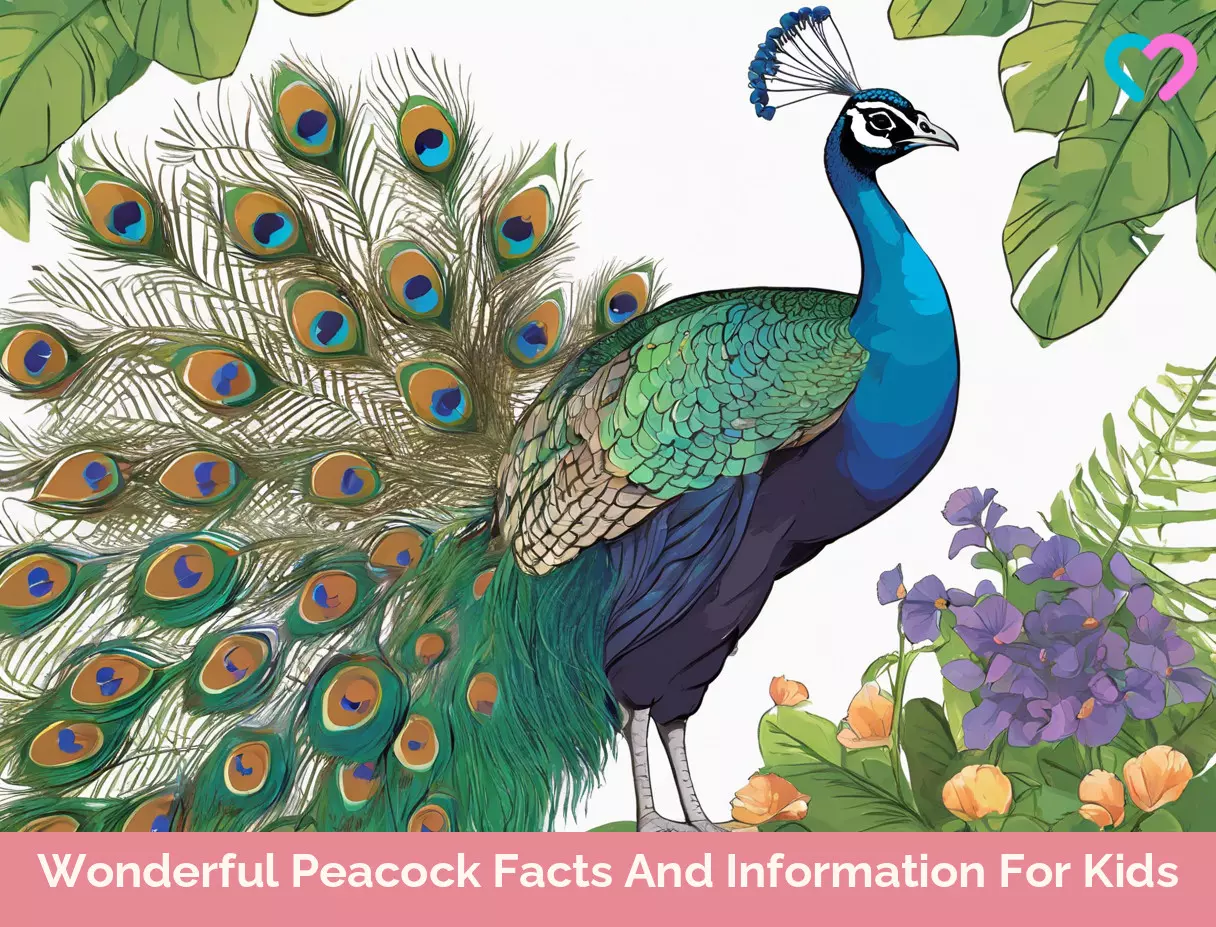
Image: Stable Diffusion/MomJunction Design Team
Peacocks are among the most beautiful birds in the world and are associated with rich cultural and religious significance. Learn interesting facts about them in the given video.
Personal Experience: Source
MomJunction articles include first-hand experiences to provide you with better insights through real-life narratives. Here are the sources of personal accounts referenced in this article.
i. A White Peacock – 一只白孔雀https://originalartstories.blogspot.com/2011/09/white-peacock.html
References
- Common peafowl Pavo cristatus.
https://nationalzoo.si.edu/animals/common-peafowl - Congo Peafowl.
https://datazone.birdlife.org/species/factsheet/congo-peafowl-afropavo-congensis - Why are peacock feathers colored?.
https://www.webexhibits.org/causesofcolor/15C.html - Peacocks need not sacrifice flying skills for.
https://www.science.org/content/article/peacocks-need-not-sacrifice-flying-skills-sexiness - Peacock Symbolism: 8 Spiritual Meanings of Peacock.
https://www.atshq.org/peacock-symbolism/ - Hera.
https://www.worldhistory.org/Hera/ - The Peacock In Sufi Cosmology And Popular Religion.
https://www.researchgate.net/publication/347242357_THE_PEACOCK_IN_SUFI_COSMOLOGY_AND_POPULAR_RELIGION - Peacocks.
https://legacy.tendringdc.gov.uk/sites/default/files/documents/environment/pollution%20%26%20noise/7.%20Peacocks.pdf - Roslyn Dakin and Robert Montgomerie; (2014); Deceptive copulation calls attract female visitors to peacock leks.
https://pubmed.ncbi.nlm.nih.gov/24642499/ - Pavo cristatus Indian peafowl; Animal Diversity Web; University of Michigan
https://animaldiversity.org/accounts/Pavo_cristatus/ - Dealing with Peafowl.
https://www.rpvca.gov/510/Dealing-with-Peafowl - Peacock Fact Sheet.
https://www.pbs.org/wnet/nature/blog/peacock-fact-sheet/
Community Experiences
Join the conversation and become a part of our nurturing community! Share your stories, experiences, and insights to connect with fellow parents.
Read full bio of Elisa Yi
Read full bio of Manjiri Kochrekar
Read full bio of Harshita Makvana
Read full bio of Ghazia Shah









